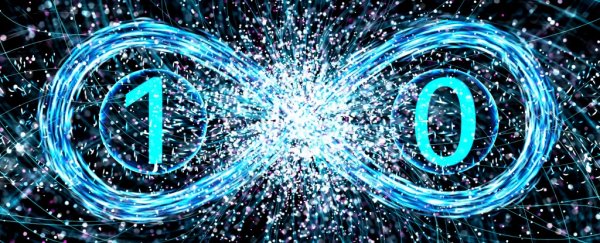For around a century it's been thought that particles don't have defined properties until we nail them down with a measurement.
That kind of quantum madness opens up a whole world of counter-intuitive paradoxes. Take this one, for example – it's possible for a single particle to experience two sequences of events at the same time, making it impossible to know which came first.
Physicists from the University of Queensland designed a race course for light that forced a single particle to traverse two pathways at once, making it impossible to say in which order it completed a pair of operations.
In boring old everyday life you could roll a single ball down a ramp and have it ring bell A and then ring bell B. Or, if you'd prefer, you could roll it down another ramp and have it ring B before A.
If you want to get fancy you could even set up a rig so one bell causes the other bell to ring.
None of this is mind blowing, since we're used to events in the Universe having a set order, where one thing precedes another in such a way that we presume an order of causation.
But nothing is so simple when we accept that reality is a blur of possibility prior to it being measured.
To demonstrate this, the physicists created a physical equivalent of something called a quantum switch, where multiple operations occur while a particle is in a superposition of all its possible locations.
Keeping it simple, the team set up a pathway that split apart and converged again in an interferometer, with access to each fork dependent on the polarisation of the light entering it.
Light waves travelling down each fork in the pathway would then merge and interfere to create a distinctive pattern depending on its properties.
In this particular case, the two light waves were actually the same photon taking both paths at the same time.
Before being measured, a photon can be either vertically or horizontally polarised. Or, more precisely, it's polarised both vertical and horizontal at the same time until a measurement confirms one over the other.
Since this undefined photon's polarisation is both vertical and horizontal, it enters both pathways, with the vertically polarised version of the photon barrelling down one channel and the horizontally polarised version heading down the second.
Following the two paths, the team had the quantum equivalent of those bells we mentioned earlier - in the form of lenses that subtly changed the shape of the photon.
The horizontal polarisation would hit 'bell' A before striking B, while the vertical polarisation would strike 'bell' B, and then A.
An analysis of the interference pattern of the reunited photon revealed signs of this mess of possible sequences.
On one hand, it's easy to imagine two separate light particles – one horizontally polarised, the other vertically polarised – passing each lens in separate orders.
That's not what happened, though. This was a single photon with two possible histories, neither of which set in reality until they're measured.
While the events A and B were independent in this quantum switch, they could be linked to affect one another. A could cause B, or B could cause A … all depending on which history you wanted after the event.
Putting aside daydreams of travelling back in time to undo that big mistake (what were you thinking?!), this does have one possible practical application in the emerging field of quantum communications.
Transmitting photons down a noisy channel could be disastrous for their quantum information, quickly making a mess of their precious superposition. Sending them down channels fitted with a quantum switch, however, could in principle give the quantum information an opportunity to get through.
A paper the team published on the pre-peer review website arxiv.org back in July shows how a quantum switch applied to two noisy channels can allow a superposition to survive.
Whatever weird clockwork is going on in reality's basement, we won't pretend to understand it. But the very fact physicists are able to craft it into new technology is truly mindblowing in itself.
This research was published in Physical Review Letters.
